Our last two major cruises were motoring on the ICW (InterCoastal Waterway) and sailing along the Caribbean chain. On the ICW, diesel is easier to find than a NYC Bagel. During our 6 months sailing south in the West Indies we used the engines for fewer than 40 hours. In both cases, fuel plans were not needed.
Our next adventures will involve long distances (3,000 miles from the Galapagos to the Marquesas), no or unreliable quality diesel (Tuamotos) and possibly light air (Bay of Panama). As is my usual habit when solving problems, I created a spreadsheet to investigate further.
Fuel gauges vary in their accuracy. I have heard that air pressure gauges and electrical sound gauges are very accurate. We have traditional WEMA float gauges, which offer a suggestion of the amount of fuel in the tank rather than a definitive statement. Also, we never push it close to empty to ensure that the engine does not suck in bottom-of-the tank gunk. I should have more faith in my multiple fuel filters.
Conservatively, (7 gallons in reserve) we have 63 gallons of diesel capacity in each tank. The builder claims 75 gallons; that may be correct if you draw out the last ounce of diesel.
At anchor, Two Fish’s batteries require very little charging since the solar panels cover the lights and other anchor based consumption. We tend to run the genset every 3 days for about 1.5 hours. However, during passage our consumption skyrockets. The solar produces 20 -30 amps for the sunny parts of the day, but the boat relentlessly consumes 21 amps every hour, whether the sun is up or down. 8 amps for the fridge and freezer, 7 amps for the navigation screen, 4 amps for the beefy autopilot and radar; other assorted bits fill in the balance.
Two Fish and other Antares boats will run their genset for 2.5 hours a day when on a 100% multiday sailing passage. To reduce the hours, I purchased a Watt & Sea hydro generator. It looks like a rudder from a sailing dinghy with a propeller attached. So far, the results have been okay. It is too early for a final verdict. The boat does not seem to travel any slower with the hydro on, so it is kind of free energy. The marketing materials are rather optimistic. The hydro can be fitted with 3 different size propellers. We fitted the largest size. It produces in the real world what the marketing gurus say is the medium size propeller’s amps. At six knots (a speed we exceed most of the time) the hydro can produce between 5 and 10 amps. This is a game changer as it replaces 1.5 to 3 hours of genset time. We might only need the genset for the watermaker! The hydro will produce almost no energy at 4 knots and at 12 knots it cuts out.
This is the plan for our 3,000 mile leg, assuming no hydro amps. Without any type of rationing, assuming a 21 day passage, we would consume 25 gallons, or 20% of our fuel by running the 2.5 hour top-up. All hail hydro.
When the wind becomes light the engine typically fills in for the loss in speed but on a long passage you have to ration your fuel.
What is the magic number of jerry cans to carry? 8 cans can fit nicely in the cockpit locker. I like to keep the weight out of the bow and stern and this has proven a convenient location when they need to be accessed. If 8 cans is not enough then tying extra cans under the cockpit table. They are not too annoying for folks sitting at the table and can be secured well with a few lines. It is a large boat and there are plenty of places to hide cans. I once put 17 cans on Two Fish and she does not sail well with that much weight. The waves are more uncomfortable and the performance is ruined. However, 8 cans and I did not notice any change.
Our usual one engine, 2200 rpm motoring speed burns .8 gallon/hour has a range of 775.5 nautical miles. That is conservative since we give no credit for the hydro generator, no bonus for motor sailing, and reduce speed by 20 percent for bad waves and wind. More realistically, over 1,000 miles is possible. In an emergency that number could double if you sacrificed speed and ran the engines at lower rpms.
I need to end this post before I become a motor boat head. Our new screecher headsail should power us up better than the engines. Next post should be about sail trim?
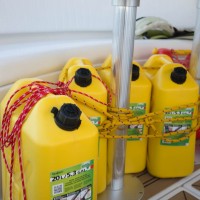
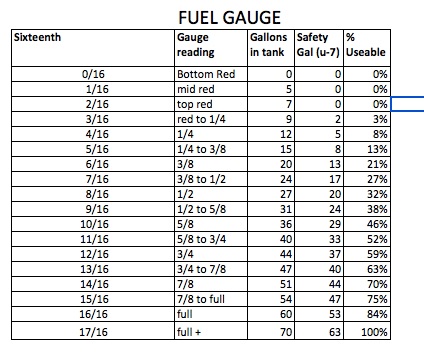
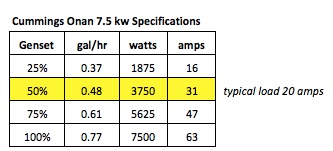
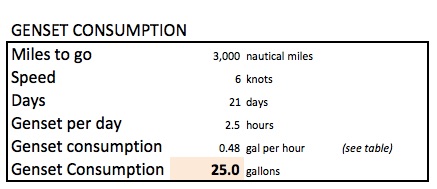

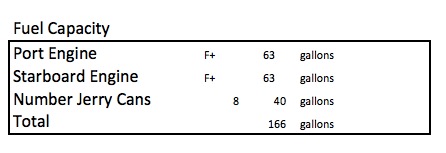
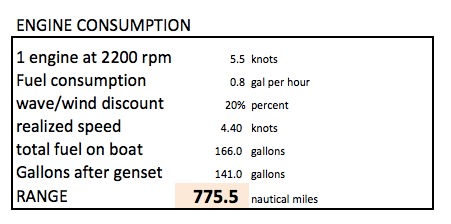
4 Responses to Fuel Management